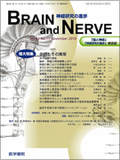Japanese
English
- 有料閲覧
- Abstract 文献概要
- 1ページ目 Look Inside
- 参考文献 Reference
はじめに
歩くことはヒトにとって最も根源的で重要な運動であり,その障害は神経症状の中でも最も多い訴えの1つである。特に近年高齢化社会を迎え,平衡障害(disequilibrium)および歩行障害(gait disturbance)による転倒(falls)の頻度が増加しているため,大きな社会問題の1つになりつつある1)。歩行障害といっても必ずしも神経系の障害によるとは限らず,むしろ脊椎および下肢骨格系の変形・異常に基づくものが多いので,その点に注意をして鑑別する必要がある。すなわち,「歩きにくい」,「転びやすい」という訴えの患者を前にした場合に,ただちに頭部や脊髄のMRIを検査するよりも,まず詳細な身体的診察によって関節・骨格系の異常に基づく歩行障害ではないか,あるいは神経系の異常によるものかを慎重に判断したうえで,検査計画を立てるべきである。本稿では関節・骨格系の異常には触れずに,神経系の異常に基づく歩行障害に限って述べる。
Abstract
Disequilibrium and gait disturbance are the most common causes of falls,which are becoming a serious social problem for the increasing geriatric population. Gait disturbance is caused not only by neurological diseases but also by joint and skeletal system abnormalities,and these abnormalities have to be taken into account before evaluating neurological conditions. The final common pathway for gait is formed by primary motor and premotor cortices,corticospinal tracts,anterior horn cells,α-motor nerves,neuromuscular junction,and muscles. The multiple other systems are involved in the control this pathway include the supplementary motor area,basal ganglia,cerebellum,brainstem nuclei such as the pedunculopontine nucleus and locus caeruleus; and feedback receptive systems such as the somatosensory,vestibular,visual (including the visual motion area),and auditory systems. Gait disturbance due to neurological diseases is classified into several types according to the characteristics of each condition: spastic gait,paralytic gait,ataxic gait,parkinsonian gait,dystonic gait,involuntary movements,combined form,and psychogenic gait disturbance. Ataxic gait is caused by lesions that involve the cerebellum,vestibular system,or proprioceptive system. Involuntary movements that interfere with gait include action tremor,chorea,myoclonus,ballism,and dyskinesia. Psychogenic gait disturbance is not uncommon and must be considered when the features of gait disturbance are incongruous with respect to its conventional forms and/or when the features and degree of gait disturbance vary over time. In such cases the family background or the patient's social environment is usually suggestive of psychogenic disorders. Correct judgment regarding the classification as well as the cause of gait disturbance is of utmost importance for choosing the most appropriate treatment for gait disturbance in order to prevent falls.

Copyright © 2010, Igaku-Shoin Ltd. All rights reserved.


